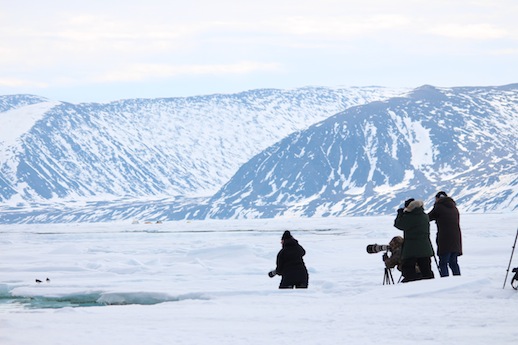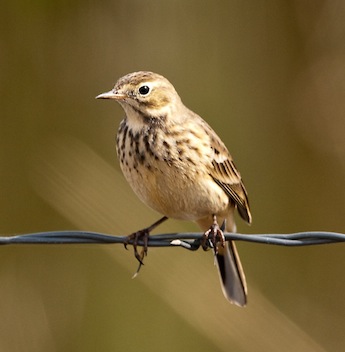Where We Are Today
On the Ice at the Edge of Baffin Bay
| One of the very best parts of it was that even when there were no Narwhals in sight, we could hear their echolocation clicks on the hydrophone. I found that totally enchanting. The songs of the Bearded Seals and the moans of the Bowhead Whales still filled our earphones, but the Narwhals’ clicks were very clear. I recommend you watch and listen to the short video at the bottom of this (somewhat slow) page to hear both their clicks and the sound of their breathing (as well as some of their vocalizations). You may note that the impression a swimming Narwhal gives can be of a huge sea serpent; this is because they have no dorsal fins, just a slight dorsal ridge. Fins would impede their travel under the ice. (Their worst predators, the Orcas, aren’t able to get at them until the sea ice melts, because of their huge dorsal fins.) |
| Ryan managed to get a lovely fluke shot and a shot of a mother and calf swimming side-by-side: |
 (Photo courtesy of Ryan and Elaine) |
 (Photo courtesy of Ryan and Elaine) |
| Also during the morning, we discovered that two Ruddy Turnstones had invited themselves into camp and were pattering about looking for food, apparently with no fear of either people or dogs. They seemed extremely pleased when they discovered the place where Philip had been cutting up some Atlantic Char. A few of us went back to the camp to photograph them during a Narwhal lull, but then they seemed to want more attention, so came out to us on the floe edge. They may soon become the most photographed Ruddy Turnstones ever to live. |
|
Ruddy Turnstones in camp (Note lashed construction of qamutiq) |
 Turnstones discovering the char (Photo courtesy of Ryan and Elaine) |
|
My best Turnstone-on-the-ice snap |
 Serious Turnstone photography (Photo courtesy of Ryan and Elaine) |
|
We also have a passerine here (in addition to the occasional Raven scavenging
on the dogs’ food). We’ve been hearing an American Pipit singing
above the camp but hadn’t been able to see it until it flew right between
Jenny and me this morning, startling us both. (We have seen no Snow Buntings
since we left Pond Inlet.)
Things had quieted by lunch time, so most of us went in for lunch. As I was walking to camp, Sam pointed out a Bowhead Whale in the distance. He was seeing it with his bare eyes. I could just make it out with my binocular. I didn’t get a great look, but there was no question what it was. (For spectacular looks at Bowhead Whales, see the 1974 National Film Board of Canada documentary In Search of the Bowhead Whale.) While most of us were eating our nice chicken soup and cheese biscuits, Emma and Sam remained at the floe edge on hydrophone watch and were startled to hear a loud bang through their headphones, which was followed by a muffled munching sound. They hadn’t heard anything like it before but both concluded that something had hit the microphone. Just then, a Walrus popped up from under the ice. Mark tried to radio the dining tent, but one of the radios had a dead battery. The Walrus was already gone by the time the rest of us heard about it, so we just kept eating. (I don’t know how Philip and Katie deal with preparing all this wonderful food knowing that we may all get up in the middle of a meal and leave it to be thrown away, or, worse, refuse to come in to eat it at all, but they are always cheerful.) We returned to the floe edge after lunch. In between Narwhals, I had a pleasant chat with Jo, who lives in London and is a stage manager. She was full of amusing tales about her work, and it was fun to share our views of British theatre. |
 American (Buff-bellied) Pipit (Photo courtesy of Wikimedia Commons) |
|
After dinner, one of the older Inuit guides, Sheatie Tagak, told us a bit of his
life story. He spoke in Inuktitut, and Sam Omik translated for him. (Here is a
short
CBC clip of Sheatie speaking Inuktitut.)
He started by telling us that his family lived out on the land when he was a
child, but then the government encouraged the Inuit to move into towns and they
went to live in Pond Inlet. For twenty-five years now, he has had a successful
guiding business,
Tagak Outfitting Services.
In response to a question, Sheatie said that he prefers modern life. Schools and cellphones and snowmobiles have made things better for the Inuit. When Sam answered the same question, however, he was less sanguine, lamenting the social changes that have come with modernization. Tom added that modern communications have made a big difference. When Arctic Kingdom began its business, they communicated with the guides by sending a FAX to the only FAX machine in Pond Inlet, knowing that they wouldn’t get a response back and just hoping the message got delivered. “Now, all these guys are on Facebook.” Sheatie went on to tell us two stories of his younger days. The first was about the time he was out hunting and had gone to sleep in his tent. He woke suddenly when a Polar Bear slashed the tent open, attracted by the smell of the char Sheatie had caught and had in the tent with him. Sheatie pulled the two sides of the rip together but couldn’t reach his gun, so he instead grabbed his kerosene lantern. When the bear broke through again, he splashed kerosene on its face and it ran away. Another time, Sheatie and his hunting buddy were out on the ice when it broke up. They jumped from floe to floe to try to get closer to land, but couldn’t make it all the way. They knew which direction the floe would travel, so they had a good idea of where they were when they were finally able to get to land. (This was in January, so they were in darkness the whole time.) They were trying to reach a friend’s cabin but Sheatie’s buddy became too cold to move. They were wearing caribou pants, so their legs were fine, but they were wearing commercial parkas, rather than caribou, so their chests and arms became very cold. When Search and Rescue finally found them after eleven days, they had to cut Sheatie’s frozen parka off to replace it with a caribou parka to warm him up while they transported him back to Pond Inlet by snowmobile. He said that he was proud to be alive thanks to S&R. (Nowadays, hunters going out on the ice can get a radio from S&R to take with them.) |
 Sheatie Tagak (Photo courtesy of Jenny Varley) |
| After Sheatie finished speaking, we all went out to the floe edge and were happy to find that the wind had died down some. The water was still rough, however, so the seeing wasn’t good. We all agreed we’d make an early night of it. Kate and I fell into bed early (i.e., before midnight). |
